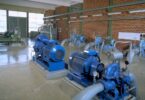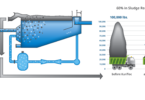Mueller Switches to a More Sustainable and Environmentally Friendly Brass
A life cycle assessment (LCA) is a systematic approach for assessing the environmental impacts from a product that occur across all stages of its life. The typical evaluation framework of an LCA covers topics such as raw materials, manufacturing, distribution, and use phases of a product, including its final disposal and recycling.
An LCA analysis can provide an enterprise with a better understanding of the parts of a product chain that carry the highest environmental burden, giving it a clearer picture of its environmental footprint and affording it more transparency with its corporate environmental disclosures. At the same time, a thorough examination of a product life cycle can uncover key findings into the processes and operations behind a product.
In this sense, LCAs can help drive decision-making by unlocking insights as to how companies can reduce environmental impacts and enhance product designs, optimize manufacturing.
While the types of measurements that LCAs provide — such as material scarcity or energy use during manufacturing — may seem broad and abstract at surface value for someone purchasing a curb stop valve or a fire hydrant, there is a well-established connection between sustainability considerations and impacts to the customer on the local level. For example, scarcity of a material influences availability, lead time, and cost of the final product. Well-executed LCAs go beyond global, esoteric considerations and push into concrete, real-world use cases that affect the user — from purchasing and sourcing to installation and end-of-life.
Applying LCA To Evaluate Lead-Free Brass Options – becoming environmentally friendly
An example of how an LCA methodology can be applied is for a company to examine and compare alternative products and materials that may be more beneficial to its operations and their customers from a sustainability perspective. Mueller used this approach to investigate alternative brass alloys.
The basis for an investigation
Historically, the AWWA C800 Underground Service Line Valves and Fittings standard was built around the use of a single leaded red brass alloy. Over the last two decades a broad range of waterworks products transitioned to alloys that meet the definition of lead-free for most surfaces contacting potable water. This was made possible given the numerous registered lead-free alloys available to the market today. However, the AWWA C800 standard only listed for use three lead-free alloys, all of which were bismuth-based brass.
In 2018, the U.S. Department of the Interior identified bismuth as one of 35 “critical” minerals — a non-fuel mineral essential to the economic and national security and with a supply chain vulnerable to disruption. While a mineral being identified as critical should not disqualify alloys containing that mineral from use, the extent of associated risks should be part of the broader evaluation. These concerns and the availability of other proven lead-free alloys, led to the revision of the AWWA C800 standard to include three silicon-based brass options.
LCA spurs new direction
With the above factors in mind, an LCA was conducted to evaluate a range of available bismuth- and silicon-based brass alloy options. The assessment considered technical performance, environmental impacts, and human health impacts across five life stages, including beginning-of-life, alloy manufacturing, component manufacturing, use, and end-of-life. The findings of the LCA include:
- The scarcity of bismuth drives significant negative environmental and human health impacts during sourcing.
- The lower melting temperature, density, and melt loss of the silicon-based brass alloys provide substantial and compounding advantages during the melting cycles of alloy and component manufacturing — reducing energy consumption, carbon dioxide creation, fume emissions, silica and flue dust generation, and the foundry sand waste stream.
- Silicon-based brass C87850 mitigates the risk of lead exposure for foundry employees and creates an opportunity to reuse foundry waste sand as it would no longer qualify as hazardous waste.
- The superior mechanical strength of silicon-based brass C87850 in relation to previously recognized AWWA C800 listed alloys provides robust structural integrity to a degree that has never previously been available for Service Brass products.
- Extra processing required for bismuth-based brass alloys during post-consumer recycling negatively impacts energy consumption, carbon dioxide generation and metal recovery.
The LCA results provided the evidence and rationale to make a significant operational change. Mueller is now transitioning from current leaded red brass and bismuth-based brass C89833 production to silicon-based brass C87850. This shift required large investments, including construction of a state-of-the-art brass foundry and is the right choice for the company’s customers and future.
To download the Mueller C87850 white paper, click here







